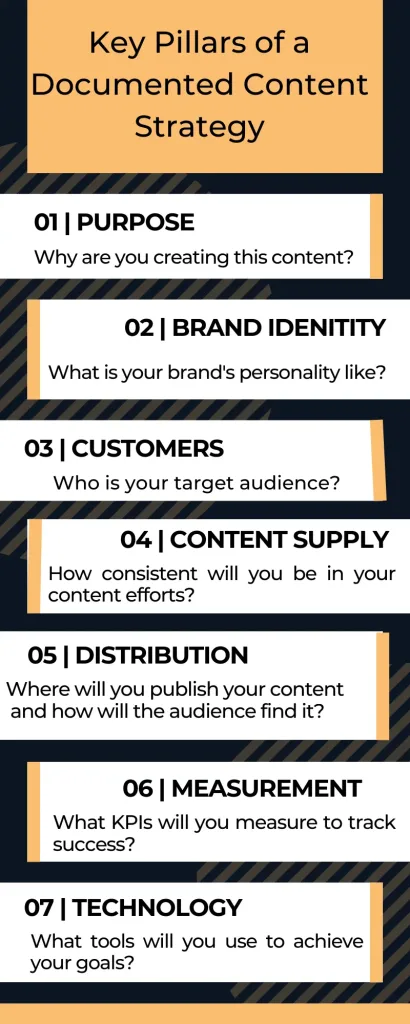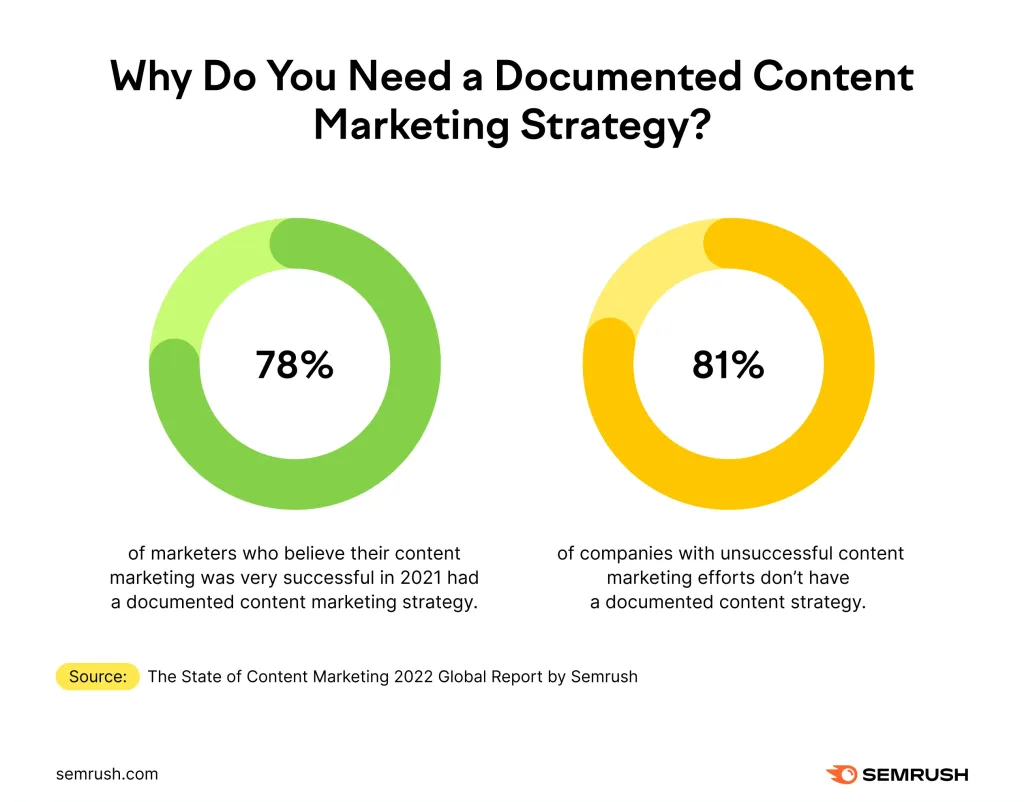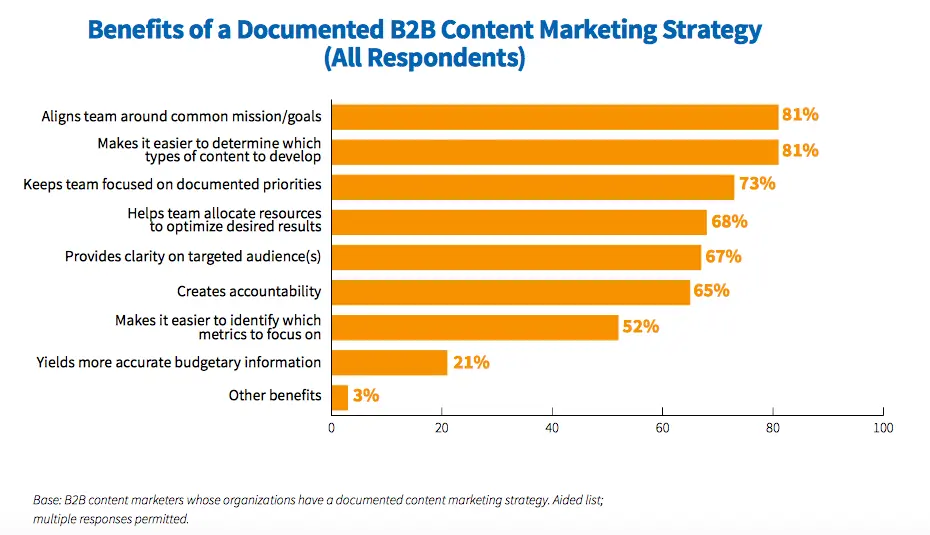Not having a documented content strategy is like driving on a highway at night without the headlights on.
You have no way of knowing if you’re headed in the right direction or using the right lane. Yes, you might eventually reach your desired destination, but it will not be without wasted resources and missed turns.
Without documenting your content strategy, you’re pretty much shooting arrows in the dark.
Turns out, it isn’t enough to have an “idea” of your content strategy – documenting the strategy is the actual recipe for success. And 64% of the most successful content marketers today have always known that.
When documented, a clearly defined, goal-based content strategy serves as a blueprint for all your content operations and keeps you moving in the right direction.
Before we understand how, let’s make sure you and I are on the same page.
What is a Documented Content Strategy?
A documented content strategy is primarily a document detailing the who, the why, the when, and the how of creating content that’ll resonate with your audience.
It clarifies your vision, defines your KPIs, the business objectives you want to accomplish using content and the steps you’ll take to get there.
It is a roadmap to guide your journey to effective content creation, publishing, distribution, and promotion.
Whether it’s clarifying questions like if you should use humor in your content or coming up with a blogging strategy your target reader will like.
Your documented content strategy should lay out the map, in a step-by-step manner, of how to reach the objectives and goals you’ve set for your team.

Having a documented content strategy is the first step to content success. Yet, only 40% of B2B marketers have taken the time to write it down.
The Power of Writing Down Your Content Strategy
Putting your content strategy in writing means business – what gets written down gets done.
Don’t believe me? A study called “The Gender Gap and Goal Study” by Mark Murphy reveals the psychology behind writing down your goals.
When you write down your goals or plans, the brain assigns greater importance to them, sees them as something to be remembered, and decides to store this information in your long-term memory.
In fact, people who clearly describe their plans, goals, and strategies in writing are 1.2 to 1.4 times more likely to achieve them.
Now that’s a 1.4x higher chance of achieving content marketing success just by committing it to paper.
But what makes a written content strategy so powerful?
A written strategy lets you establish uniformity and make sure that everyone is on the same page – working towards a common goal. This alignment also makes it easier to:
- Define your content marketing KPIs in line with your overall goals
- Determine how to position your brand in your content
- Understand which type of content formats and channels to use
- Track your progress and find ways to improve the content strategy

Creating an official content strategy makes a case for your marketing approach – it clearly shows why you are investing in content and what you plan to achieve with it.
But don’t take my word for it. Here’s a case in point.
Campman, a small online retail shop specialising in outdoor gear and clothing, adopted content marketing to compete against industry giants like Backcountry.com and REI.
Within a few weeks of regularly publishing compelling content and creating a solid presence on social media, the brand achieved 10X email revenue and doubled the website traffic.
And can you guess where it all began? Yep – with a personalised content strategy documented for their team to refer to as and when needed.
In short, documented content strategy is the holy grail of every content marketing plan. And it’s time you tap into its potential too.
4 Benefits of Documenting Your Content Strategy
1. It Helps You Focus on Common Goals
Documenting your content strategy can be a time-consuming process. So, it makes sense why many marketers avoid committing the time and energy to it.
But no marketer can deny the importance of a content strategy. As you know, content marketing trends change at a breakneck speed. And it is nearly impossible to keep up or achieve your content goals without having a roadmap with clear objectives.
Whether you want to focus on brand awareness, lead generation, thought leadership, or SEO, a documented content strategy will save you from making uninformed choices and keep your team on track.
The bottom line? You’re less likely to lose track of your efforts and reach your content goals faster.
2. Documenting Your Content Strategy Clarifies Your Target Customer
Every successful marketing strategy begins with understanding the target audience. You need to know how they think, what their needs are, and how your brand can help address those needs.
Besides, identifying 4 to 5 core pain points of your ideal customer will provide an excellent framework to build effective buyer personas, and ultimately, create content that resonates with them. This way, you’ll also never run out of content ideas.
However, all these efforts will be fruitless unless you write everything down! Documenting what you know about your audience gives you a focal point for every decision you make moving forward.
Your team also gets a comprehensive view of the people they are targeting, allowing them to deliver higher value.
3. It Lets You Plan and Create Better Content
Have trouble coming up with original content ideas? With a documented strategy, you can say goodbye to those.
In no time, you will find it easier to come up with interesting topics and ideas to boost engagement. You will not only know what type of content you need to publish, how often, and on which platforms, but also what metrics to track to better gauge your ROI from content.
4. It Helps You Better Allocate the Available Resources
With a formal, documented content strategy, you have access to every project, campaign, and content calendar in detail. This makes it easier for you to allocate limited resources (personnel and finances) effectively to get the best possible results.
Moreover, you can easily recognise who on your team is best suited to handling a particular project. Or determine if you need to hire more content writers or part-timers to keep the project running smoothly. And – best of all, it can also give the management a basis for higher budget requirements.
When a consistent supply of high-quality content is essential to keep prospects and customers engaged, you can’t afford to have limited resources.
In such a case, a documented strategy can help you convince and get buy-ins from your executives and keep the content going.
If these four benefits weren’t enough, check out the other advantages you can enjoy with a documented content strategy.

How to Go About Documenting Your Content Strategy?
Now that you know how powerful a documented content strategy is, gather your team to start creating one.
- Start by outlining your broader business objectives. It could be boosting search engine rankings or getting more backlinks. Then, find out how content can aid in achieving those objectives.
- Based on those, set goals you want to achieve and in what time. You should also cover three important things: tools you’ll be using, processes to follow, and workflow to understand the content lifecycle from creation to distribution.
- Next, write down a set of guidelines for each content process: creation, publishing, distribution, promotion, and performance assessment. Be as comprehensive and as generous with the details here.
- Now, what happens if your current strategy doesn’t work? In such a case, you need to provide a feedback loop telling your team about the next steps and whether they should scrape the entire strategy or change the ineffective part.
- Lastly, upload the document in a place accessible to anyone on the team. That way, they will always have a roadmap to guide them.


8 thoughts on “Does Documenting Your Content Strategy Make a Difference?”